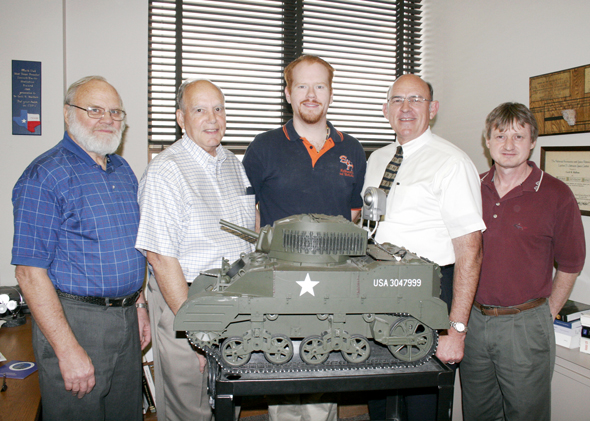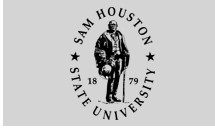Interdepartmental Effort Gets SHSU Into Robotics--Cheaply
 |
From left, Dave Luning, John McCoy, Jason Minter, Cecil
Hallum, Gary Smith, with their WiFi-controlled 1:6 scale
model M5 Stewart Tank.
--Photo by Saby Hernandez |
A small group of revolutionaries in the math/statistics and
computing science departments at Sam Houston State University
is building an army of the future. They already have the armor
and are planning for an air force.
It started
with a 1:6 scale M5 Stewart Tank that math professor Cecil Hallum
found on e-Bay for $99.
Hallum began
looking for a vehicle like that when he and other faculty
members discussed ways that remotely-sensed digital imagery
could be mathematically quantified, and the rapidly growing WiFi
environment that they expect to eventually blanket the United
States.
More than 80
cities have WiFi networks, which allow anyone with a computer
to go online from any location within that grid, wirelessly.
Just recently the Houston City Council approved a network that
will be one of the largest of its kind in North America, with
expected completion in 2009.
With that news,
robot antennae began to vibrate and tiny lights twinkle, in anticipation
of their business and government masters being able to control
them remotely using computers instead of radio frequencies.
Potential uses
include searching for bodies, assessing damage in hard to reach
areas after a disaster such as a hurricane, searching for hidden
weapons and watching the border for illegal immigrants.
The problem
with vehicles controlled by radio frequencies is that they must
stay within range of their control signal. The SHSU team took
a radio frequency controlled device--the tank--and converted
it to WiFi control.
It was a relatively
inexpensive project. In addition to the $99 e-Bay tank, it required
a $59 wireless router from Office Depot, $99 for their own URL
address, and $119 for a small Web camera that could be mounted
on the tank's turret.
All the hardware
needed cost less than $500, Hallum estimates, not including his
14-ounce OQO computer with a 2.0 Gigahertz processor that was
inserted into the area of the tank where the crew and ammunition
would usually go.
"We wanted
to show that something like this could be put together that the
general public might be able to afford," said Hallum.
Doing the grunt
work on the project was an army of old soldiers and one raw recruit.
Dave Luning,
who retired from full-time teaching in math in 2004, and John
McCoy, professor emeritus of computing science, who retired in
2003, both chipped in. McCoy was in charge of the wiring, and
Luning directed the overall hardware configuration effort.
The junior
officer was Gary Smith, associate professor of computing science,
who created the software. Smith is so convinced of the future
usefulness of such technology that he is working to create a
robotics laboratory in the computing science department.
The foot soldier
in the project was graduate student Jason Minter, who did his
master's thesis on the statistical aspects of converting data
from the tank's camera to useful images. Minter graduated in
December and moves on to SMU this fall for doctoral work in mathematics.
The project
has provided a little extra excitement around the math/statistics
offices. You never know when you'll come around a corner in some
hallway and meet a tank roaring along as if operated by some
tiny rodent.
What is actually
happening is that Hallum is demonstrating his creation, and it's
probably being driven from some room that's out of sight by a
high school student from Huntsville or New Waverly, who have
both brought groups to see it.
The secretaries
say that so far it hasn't been too bad, but they don't know
what to expect from the next step in General Hallum's campaign
plan. This will be an airborne vehicle such as a blimp or helicopter.
Minter explains
that the tank was selected as the first tool because it "can
carry a relatively large payload for its size and it is less
prone to complete destruction than an airborne vehicle."
Hallum said the project has already been a good recruiting
tool for the university, and he looks forward to the next stage.
He already has a couple of graduate students lined up and interested
in taking over what Minter started, and the motor pool volunteers
are ready for the next phase of Sam Houston State University's
entry into the world of robotics.
—END—
SHSU Media Contact: Frank Krystyniak
April 24, 2007
Please send comments, corrections, news tips to Today@Sam.edu.
|


